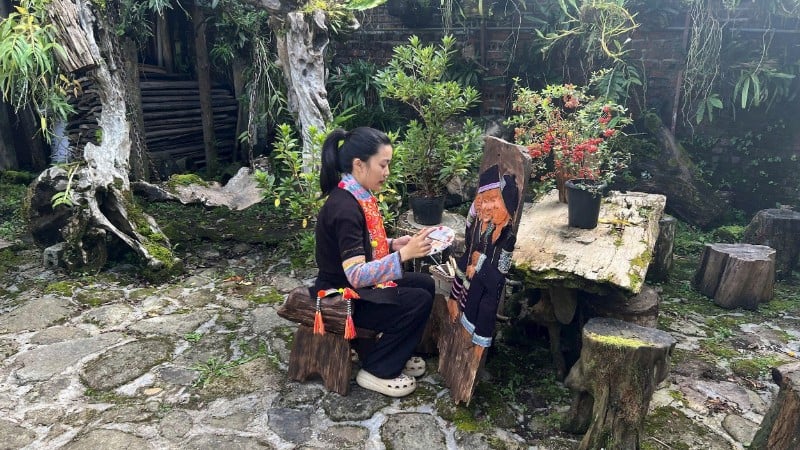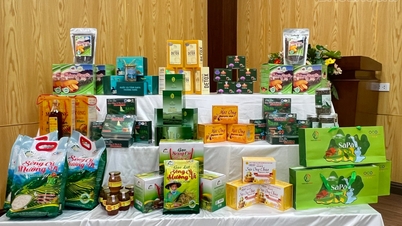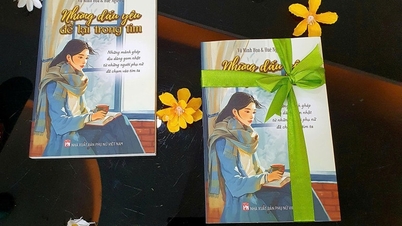
From her initial love of painting, she chose her own path of turning seemingly rough boards into works of art containing the soul and traditional culture of ethnic minority communities.
Sa Pa Hotel is located on Dien Bien Phu Street leading to the center of Sa Pa in Lao Cai province, but if you do not pay attention, everyone will not know that this is also an art space for those who love sculpture, especially wood sculpture, to explore .
Carving mountain and forest stories on wooden boards
I arrived at Sa Pa Khi Hotel in the early afternoon, just when Lan Anh and her brother and sister were busy making paintings to send to Phu Quoc ( An Giang ). The paintings were really beautiful, very impressive, suitable for the purpose of decorating the hotel in the style of the Northwest highlands. The hotel owner, Nguyen Tien Dung, said that if people only looked at the photos, they would not see the identity, origin, and tradition of the highland villages appearing in each grain and the characteristic aroma of the wood.
I say so because this is a wood shingle painting, with a combination of art forms such as sculpture, painting and brocade decoration, and each chisel stroke, each drawing line, each piece of brocade attached, seems to contribute to awakening the memories of the mountains and forests in the wood. Lan Anh shared that the wood shingles are taken from the roof shingles of the H'Mong and Dao people, completely made of po-mu. Po-mu is a rare wood, the wood has oil in it that is water-resistant and termite-resistant. Therefore, ethnic minorities often use po-mu wood to roof their houses and many roofs are hundreds of years old.
However, over time, the weather was erratic, some of the po-mu wooden roofs were cracked and punctured and people did not have a uniform replacement material due to the ban on logging. They had to replace the po-mu roofs with corrugated iron roofs and Lan Anh bought and reused those discarded po-mu wooden shingles. Lan Anh will explain to me later why she used po-mu wooden shingles to create the paintings. As for the process of creating a wooden shingle painting, after bringing it home, the girl born in 1994 will thoroughly clean the shingles. She will handle any warped or cracked pieces. Next, she sketches the idea on the shingles, then sculpts the rough part. After that, she attaches brocade, paints the characters' faces, adds patterns and motifs typical of the Northwest highlands, before covering the painting with a protective layer.
Interestingly, although she is not an ethnic minority, the girl born in 1994 loves the themes of the highlands. The content of the paintings is often associated with a story in the daily life of the people, so they become vivid and close to the viewer, as Nguyen Nhu Quynh, a tourist from Hanoi staying in Sa Pa Khi commented. Quynh said she was very impressed with the painting of a H'Mong mother and child going to the spring market, with peach blossoms and bird cages, which are very typical of the Northwest. Or the painting of a Dao mother and child in the summer, with peaches and plums.
According to Lan Anh, she often depicts many scenes of people's daily life and their portraits in her shingle paintings rather than delving into festivals and customs because that will clearly and authentically depict the people of the highlands. Therefore, familiar images in her shingle paintings always include children, especially mother and child scenes. Lan Anh explains that the daily life of ethnic minorities is always about mother and child, such as mother taking her child to the fields, mother taking her child to the market...
The young girl's thoughts were not necessarily because she was the mother of a 5-year-old boy, but also because she grew up in Lao Cai since childhood with a love of art that was gradually kindled through the artistic soul of her father, Mr. Tran Van Khi.
Father to son
The path that led Lan Anh to painting and shingle painting cannot be mentioned without mentioning Mr. Khi, who is quite famous in Sa Pa with the stage name Sa Pa Khi. Now 65 years old, Mr. Khi has been involved in wood carving for more than 30 years without any formal education. He said that in the past, he only grew orchids to sell to tourists coming to Sa Pa. In those days, he often went to the forest to find orchids, picked up tree roots floating in streams, house pillars, and buffalo pens to make pseudobulbs.
After each trip, he brought back many tree roots and pieces of wood with interesting shapes and with his soul loving beauty and the eye of an artist, artistic shapes and wooden paintings gradually appeared after each chisel stroke. The works he created were simple, rustic, clearly depicting the people of the highlands. Therefore, he turned the small garden behind his house into an art space with wooden houses for rent to tourists, wooden statues and wooden paintings hung around the house used as a place to rest and drink tea.
Life went on peacefully with Mr. Khi's family and the hotel business. In fact, the Covid-19 pandemic led their youngest daughter to other paths other than the tourism major she studied and had been attached to for six to seven years in Lao Cai due to the difficult situation at that time.
After quitting her job, Lan Anh gave birth and decided to move to other industries and professions. It is not clear whether fate led her to follow Mr. Khi's path or not, when from her love of painting, she came up with the idea of shingle paintings. Lan Anh recalls that sculptures when displayed on screen also attracted many people but were still more selective than colored paintings. She and Mr. Khi both liked brocade but they did not know how to apply it to paintings. After thinking for a long time, the idea finally came back from childhood memories. When he was young, Mr. Khi often carved rustic wooden dolls without clothes for his two daughters to play with.
And when she started painting, during her wanderings around the highland markets to learn about brocade, patterns and creative ideas, Lan Anh asked for many scraps of fabric from ethnic minorities. At first, she attached those pieces of fabric to dolls, painted their faces and then posted them on TikTok to show off. Unexpectedly, people welcomed and cared for her, and from there, she came up with the idea of incorporating brocade into her father's sculptures.
Therefore, over the past two years, the name Lan Anh Hoa Moc has gradually become familiar to the public through unique shingle paintings. According to Lan Anh, the most difficult part is carving. The shingle wood is not flat, and is recycled wood, so it has cracks and warps. Each board must have content that matches the shape and grain color.
However, the girl born in 1994 is still loyal to this material because of very simple thoughts. Firstly, shingle wood has been associated with the highland people for hundreds of years, as if in each vein of wood there is the life and culture of the community. Secondly, shingle wood, which here is po-mu wood, has a special fragrance of the mountains. Therefore, shingle paintings or wooden dolls, besides being dressed in the colors and costumes of the highland people, also have the fragrance of the mountains and forests, of the national identity. It is the fragrance and cultural tradition that she wants to depict, not the lifeless pieces of wood.
Currently, Lan Anh's main customers are hotel owners who want to decorate their spaces in a local style. In the long term, she plans to create more compact, portable products to serve tourists. She even has the idea of turning this job into a creative experience: preparing wooden blocks, cutting brocade, so that tourists can complete their own work, both as souvenirs and memories of the land and people of the Northwest.
According to Quynh, it is wonderful that people can come to Sa Pa Khi Hotel, not only to rest, but also to immerse themselves in an artistic space, where the pơ-mu boards that once protected the people of the highlands from the rain and sun have now become a place to preserve memories. She said that through the hands and soul of Lan Anh, as well as the talented chisel of Mr. Khi, they are not just wood, not just paintings, but also stories about people, about the mountains and forests of the Northwest. And in fact, the gentle scent of pơ-mu lingers in each work, bringing viewers back to the village, to the eternal way of life.
Source: https://nhandan.vn/van-go-ke-chuyen-nui-rung-tay-bac-post916201.html



![[Photo] Immerse yourself in the colorful musical world of “Secret Garden Live in Vietnam”](https://vphoto.vietnam.vn/thumb/1200x675/vietnam/resource/IMAGE/2025/10/18/1760805978427_ndo_br_thiet-ke-chua-co-ten-41-png.webp)
![[Photo] Collecting waste, sowing green seeds](https://vphoto.vietnam.vn/thumb/1200x675/vietnam/resource/IMAGE/2025/10/18/1760786475497_ndo_br_1-jpg.webp)
![[Photo] General Secretary To Lam attends the 95th Anniversary of the Party Central Office's Traditional Day](https://vphoto.vietnam.vn/thumb/1200x675/vietnam/resource/IMAGE/2025/10/18/1760784671836_a1-bnd-4476-1940-jpg.webp)
![[Photo] Closing ceremony of the 18th Congress of Hanoi Party Committee](https://vphoto.vietnam.vn/thumb/1200x675/vietnam/resource/IMAGE/2025/10/17/1760704850107_ndo_br_1-jpg.webp)














![[Photo] Immerse yourself in the colorful musical world of “Secret Garden Live in Vietnam”](https://vphoto.vietnam.vn/thumb/402x226/vietnam/resource/IMAGE/2025/10/18/1760805978427_ndo_br_thiet-ke-chua-co-ten-41-png.webp)

![[Video] Warning about scams through calls for support for flood victims](https://vphoto.vietnam.vn/thumb/402x226/vietnam/resource/IMAGE/2025/10/18/1760802081989_illustrated-natural-disasters-education-presentation-png.webp)











































































Comment (0)